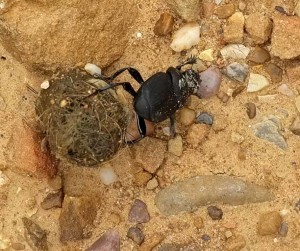Recently, along an equestrian trail at Lake Mineral Wells State Park, I met someone with that same job. Amid a patch of loose stones, a determined black beetle walked backwards, head down, its hind legs rolling ball of horse dung across the path. For every few inches it advanced on the rocky terrain, it lost one as the dung ball slipped back downhill for this persistent little Sisyphus.
I’d read about dung beetles before, but had not seen one in action.
“They slurp it, haul it, roll it, fight about it, and bury it…,” Texas ecologist Dr. Pat Richardson is often quoted as saying of the beetle’s love of dung. “They don’t bite or spit or sting. They simply live, eat, sleep and dream dung.”
An army of dung beetles can transport tons of manure from a pasture in a matter of days, and in some parts of Texas they remove as much as 80% of the cattle droppings.
Their massive waste hauling operation is a boon to ranchers and farmers,
- Clearing pastures for livestock foraging
- Promoting healthy soil by infusing it with rich organic matter
- Interrupting the life cycle of parasites consumed by livestock
- Eliminating a breeding ground for horn flies and other livestock pests
In fact, to bring more beetle to bear on the state’s pastures in the 1970s, U.S. Department of Agriculture scientists imported a diligent species from Africa – Onthophagus gazella – and released it here, where it quickly spread throughout the state.
It’s hard to tell from my slightly blurry photo what species of dung beetle I saw. I browsed the 56 pages of dung beetle mug shots on the BugGuide, but they were just too similar to pick one out of the lineup.
“Which one of these rounded black beetles was the one you saw on the path on the day in question?”
“I thought perhaps Canthon lecontei on page 7.”
“Take your time. Are you absolutely sure that’s the beetle you saw?”
“Well, to be honest, no. His face was covered in dung.”
When I posted a query on the site’s bug identification pages, within a few minutes I had my answer, courtesy of a beetle aficionado and professional microbiologist with the CDC’s Division of Parasitic Diseases and Malaria. My dung beetle was a Canthon imitator.
(Identifying a dung beetle is no small feat. There are more 6,000 species worldwide. And beetles in general are the most abundant species on Earth, with more than 350,000 identified so far. They account for about 40% of insect species and 25% of all animals.)
Dung beetles divide into three categories in increasing order of laziness. Mine was a “roller” that cuts and shapes balls of dung and tumbles them home to its burrow. “Tunnelers” excavate the ground right below a pile of dung to bury it. “Dwellers” just wallow in the dung where it sits.
“Rollers” such as the one I saw fly from field to field, sniffing the air for the alluring odor of manure. After dropping onto a pile, they use serrated claws on their front legs to cut and form dung balls and dig their burrows.
Ounce for ounce, they may be the world’ strongest insect, according to a British study:
Dung beetles, it’s fair to say, have always punched above their weight… Plucky male onthophagus taurus can pull 1,141 times their own body weight: the equivalent of an average person pulling six double-decker buses full of people.
You wouldn’t expect it, but apparently, the competition for livestock droppings is fairly intense, and these tumblebugs will often make a grab for each other’s dung. The goal of a dung beetle then is to get its dung ball out of harm’s way as quickly as possible. It does this with startling efficiency, plotting a straight line out of the dung patch no matter what the obstacles in its way. To navigate, it periodically climbs atop its dung ball and orients itself using whatever light source is available – the sun, the moon – even the stars of the Milky Way.
Dung beetles feed on the nutrients and moisture in their dung balls and and use them to raise their young. They lay eggs inside large “brood balls”, which provides the developing beetles with a roof over their heads and a well stocked larder. When they’re ready, they simply eat their way out of house and home.
As much as dung beetles appear to enjoy their work, I cannot think of a more dismal life. It is perhaps the last stop for a soul burdened by an accumulation of bad karma.

You must be logged in to post a comment.